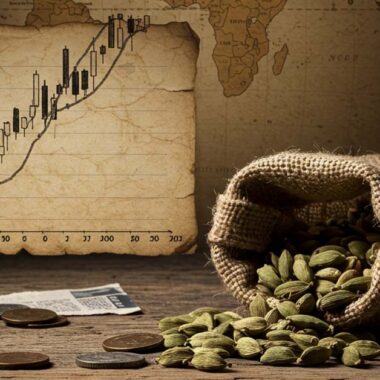Cardamom, often called the “Queen of Spices,” is a high-value crop cherished for its unique flavor and aroma. As the demand for cardamom grows globally, there is an increasing push for sustainable farming practices to ensure the long-term viability of cardamom production. While sustainable farming can offer numerous benefits, it also comes with its own set of challenges that can make it difficult for farmers to adopt these practices.
In this blog, we’ll explore the challenges faced by cardamom farmers in adopting sustainable practices and the ways to overcome these hurdles. 🌿
1. High Initial Investment Costs 💰
One of the primary challenges of transitioning to sustainable cardamom farming is the high initial cost of adopting eco-friendly practices. For instance, switching to organic fertilizers, setting up irrigation systems like drip irrigation, and integrating agroforestry can be expensive.
Farmers may also need to invest in:
- Training and education on sustainable farming techniques.
- Infrastructure like greenhouses or rainwater harvesting systems.
- Tools and equipment for soil management and pest control.
While these practices can reduce long-term costs and environmental impact, the upfront investment can be a significant barrier for many small-scale farmers, especially in regions with limited access to financial support. 💸
2. Lack of Access to Knowledge and Resources 📚
Sustainable farming requires knowledge of modern techniques, such as organic farming, water conservation, and pest management. Unfortunately, many farmers in regions where cardamom is cultivated may not have access to the necessary education or resources to make the transition.
This lack of access to:
- Training programs on sustainable practices.
- Expert advice from agronomists and environmentalists.
- Sustainable farming tools and technologies.
can make it difficult for farmers to adopt and maintain eco-friendly practices. Overcoming this challenge requires collaboration with agricultural extension services, NGOs, and government initiatives to provide education and resources to farmers. 🌱
3. Pest and Disease Management Without Chemicals 🦠
In conventional farming, synthetic pesticides and fungicides are often used to manage pests and diseases. However, sustainable cardamom farming encourages natural pest control methods, which can sometimes be less effective or more labor-intensive.
Some of the challenges in organic pest control include:
- Increased reliance on manual labor to monitor and control pests.
- The use of organic pesticides, which can be less effective and more expensive than chemical alternatives.
- Crop rotation and agroforestry techniques that take time to establish and show results.
Finding ways to effectively manage pests and diseases without relying on harmful chemicals is a significant hurdle for many cardamom farmers. It requires creativity, persistence, and access to organic pest control solutions. 🌿
4. Water Scarcity and Irrigation Issues 💧
Cardamom requires a humid, tropical climate and significant water to grow well. However, in many cardamom-producing regions, access to water can be limited or unpredictable. This makes sustainable water management even more critical.
Some challenges related to water management in sustainable farming include:
- Droughts or seasonal water shortages, which can severely affect cardamom yields.
- High costs associated with setting up water-saving technologies, such as drip irrigation or rainwater harvesting systems.
- Over-extraction of groundwater, leading to the depletion of local water sources.
To tackle these issues, cardamom farmers need to focus on efficient water use and conserve water resources through technologies that ensure water is used wisely and sustainably. 🌦️
5. Climate Change and Unpredictable Weather Patterns 🌡️
Cardamom cultivation is highly sensitive to climate conditions. The crop requires a steady and consistent climate with a good balance of rainfall and temperature. Unfortunately, climate change is causing more unpredictable weather patterns, such as:
- Excessive rainfall or flooding, which can damage crops.
- Heatwaves that can stress the plants and reduce yields.
- Changing growing seasons, which can lead to irregular harvest times.
These unpredictable weather patterns make it increasingly difficult for cardamom farmers to plan their farming activities and can significantly affect crop yields. Addressing these challenges requires adopting climate-resilient farming practices, such as choosing more resistant varieties, adjusting planting schedules, and using microclimates to protect crops from extreme weather. 🌪️
6. Market Price Fluctuations 📉💵
Sustainable farming may often come with higher production costs due to the need for organic inputs, water-saving technologies, and more labor-intensive processes. Unfortunately, market price fluctuations can make it difficult for farmers to secure a stable income.
Some challenges related to market prices include:
- Low market prices for cardamom due to global competition and oversupply in the market.
- Unpredictable price swings, which may not reflect the higher costs of sustainable production.
- Lack of access to fair trade markets that support sustainable farming.
To overcome this challenge, it’s essential to create awareness about the premium quality of sustainably grown cardamom and establish direct market links to consumers who value organic, eco-friendly products. 🏷️
7. Limited Access to Organic Certification 🌍✅
Farmers who adopt sustainable practices often seek organic certification to distinguish their products in the market. However, obtaining certification can be a complex and expensive process, particularly for small-scale farmers.
The challenges of obtaining organic certification include:
- High certification costs for small farmers, who may not have the financial resources to pay for the certification process.
- Long waiting periods before certification is granted.
- Complex documentation and adherence to specific organic standards.
Despite these challenges, organic certification can significantly boost a farm’s marketability. Governments and certification bodies can support farmers by providing financial incentives and simplifying the certification process. 📜
8. Soil Degradation and Fertility Loss 🌾
In some regions, unsustainable farming practices have led to soil degradation and loss of fertility. Cardamom requires fertile, well-drained soil to thrive. However, excessive use of chemical fertilizers in conventional farming has led to soil imbalances and nutrient depletion.
Sustainable practices, such as:
- Crop rotation.
- Composting.
- The use of green manures.
can help restore soil health and ensure the long-term viability of cardamom farming. However, these practices take time to show results and can be labor-intensive. 🌿
🌱 Conclusion 🌍
While sustainable cardamom farming offers many benefits, such as environmental preservation, higher quality crops, and biodiversity conservation, it also comes with its share of challenges. High initial costs, limited resources, pest management without chemicals, water scarcity, and market price fluctuations are just a few of the obstacles that farmers face.
However, with education, collaboration, and innovation, these challenges can be overcome. By promoting sustainable practices and creating stronger market links for sustainably grown cardamom, we can ensure that the spice remains a valuable and environmentally friendly commodity for generations to come. 🌍🌱
At Greengold Guide, we are committed to promoting high-quality cardamom grown using sustainable methods. 💚












